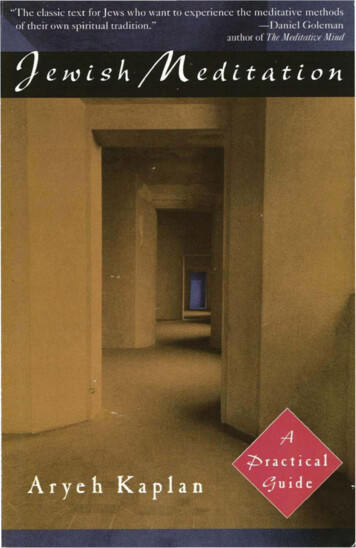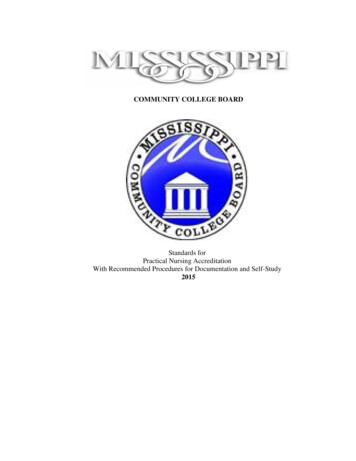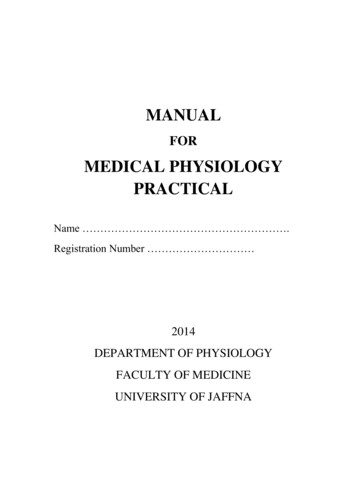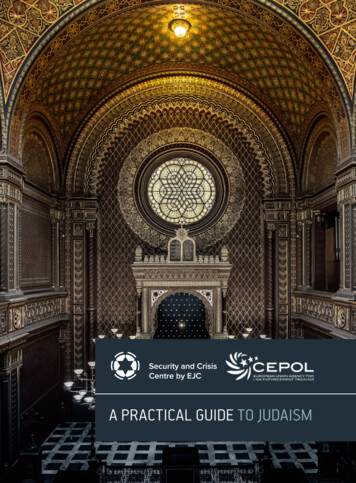
Transcription
A PRACTICAL GUIDE TO JUDAISM
A Practical Guide to Judaism-2-A Practical Guide To Judaism-3-
FOREWORDThe 42 national Jewish communities across Europe represented andfederated by the European Jewish Congress, have great respect andadmiration for the police and law enforcement authorities, as wellas profound appreciation for the courage, dedication and hard workthat they show every day to keep European Jews safe in their homes,at their places of worship and in the streets.Today, Jewish communities face important security challenges.With antisemitic violence on the rise, strengthening the security ofEuropean Jewish citizens is an immediate necessity that requires increased attention, propermeans and timely action.Through the Security and Crisis Center (SACC by EJC), the European Jewish Congressseeks to build security awareness within our community and improve crisis managementand resilience. Just as it is vital to build the structures that support a secure Jewish life,so it is equally vital to reach out to our fellow citizens, build bridges and promote mutualunderstanding.We believe that sharing our culture and religious traditions through this Guide to Judaismcontributes not only to build trust and familiarity, but also to help law enforcement andall relevant actors in the field of security to better understand our needs and address ourchallenges more efficiently. At the same time, we believe in the importance of contributingto European society, of which we form an integral part. We share our experience and bestpractices with others, and learn from the experience and ideas that others share with us.Let us work together for a more peaceful, secure and tolerant Europe.Dr. Moshe KantorPresident of the European Jewish Congress
A Practical Guide to JudaismPREFACEThe last few years have seen new threats appearing in Europe. The responsibility for thesecurity of European citizens lies primarily with the authorities. Thanks to the essential workof law enforcement and prosecutors many attacks were prevented.Although the cooperation between civilians and law enforcement has been of crucialimportance, it requires to be developed even further. Jewish communities in particular havebeen facing additional pressure with targeted attacks and threats. With this guide, we aim tofacilitate communication between law enforcement and Jewish communities.SACC by EJC and CEPOL have joined their expertise to offer a guide, which aims to give thenecessary knowledge of the traditions, holidays and other cultural aspects of Judaism. Thesetraditions often prescribe some elements of the daily life of individuals in Jewish communities.We strongly believe that it is essential to equip law enforcement officials with this informationin order to have a better understanding of Jewish community life and to be more efficient onthe field and ensure the security of their fellow Jewish citizens.This guide offers answers to many interesting questions - Why do Jewish worshippers walkto the synagogue on Shabbat? What is Rosh Hashana? Why is there something affixed at thedoorpost of some buildings? What is antisemitism and how to recognise it?We invite all law enforcement officials to study this guide, to continue to improve her/hisskills and to contribute to the security of our European society.Ophir RevachSACC by EJC - CEO-6-Dr. h. c. Detlef SchröderCEPOL Executive Director-7-
JUDAISMIntroductionJewish religious denominationsJudaism in Europe111314ContentsJEWISH TRADITIONSThe circle of life in JudaismDietary lawsThe SynagogueThe ShabbatJewish holidaysRosh HashanaYom KippurSukkotSimchat TorahChanukahTu BiShvatPurimPesachShavuotTisha B’av192022242526262727292929313131COOPERATION WITH JEWISH COMMUNITIES32ANTISEMITISMWorking definition of antisemitismContemporary antisemitism in Europe3538WHO WE ARE40
A Practical Guide to JudaismJUDAISMJudaism is the religion of the Jewish people. The Jewishpopulation around the world is estimated at approximately14.6 – 17.8 million. Judaism is one of the oldest monotheisticreligions and is considered the tenth largest religion in theworld.The Torah is the foundation text, which encompasses thephilosophy and culture of the Jewish people. The Torah ispart of the “Tanach” which is also known as the Hebrew Bible,and contains other texts, practices, theological positions,and forms of organisation.Judaism was created in the Middle East during the BronzeAge and has had a strong influence on Christianity and Islamto this day.- 10 -- 11 -
A Practical Guide to JudaismJewish religious denominationsOver the years, Judaism has diversified into several branches with differentviews on various issues and ways of life. The following main denominationscan be distinguished: Orthodox (Haredi), Modern Orthodox, Conservativeand Reform.JudaismOrthodox and Modern OrthodoxOrthodox Jews regard the Torah as the mainsource of Jewish law and ethics, as revealedby G-d to Moses on Mount Sinai and faithfullytransmitted ever since. They observe Halakha(religious law), which is to be interpretedand determined only according to traditionalmethods and in adherence to the continuumof received precedent through the ages.Among Orthodox Jews, Haredi Jews adheremore strictly to tradition and are the mosteasily identifiable due to their distincttraditional clothing. They will keep most oftheir skin covered and will put on suits formen and dresses for women. Married womenwill also cover their hair. Haredi men weara ritual fringe called Tzitzit, and a skullcap(kippah), they tend to grow beards and someof them will wear black hats with a skullcapunderneath.Modern Orthodox Jews adhere lessstrictly to tradition and tend to dress ina contemporary manner. They are moreintegrated into secular culture and societyand are not identifiable as a distinctivegroup, though many men will wear a kippahas headwear.Conservative, Masorti and ReformConservative or Masorti Judaism developedin the first half of the 20th century in theUnited States. It perceives Halakha as- 12 -binding but always subject to great external influence. Conservatives believe thatreligion must be continued in accordancewith changing circumstances and not necessarily with a precedent from the past.Reform Judaism, also known as Liberalor progressive Judaism, developed inGermany in the 1930s and 1940s. Itemphasises the evolving nature of thefaith, the superiority of ethical aspects toceremonial ones.More liberal Jewish denominations havea different interpretation of Shabbatobservance or kashrut. In addition,women may become rabbis and men andwomen sit together in the synagogue.Secular JewsThere are also many Jews who areunaffiliated to any denomination ofJudaism, and who do not keep any of thetraditional laws, but who still identify asJews. Secular Jews may celebrate Jewishholidays as cultural celebrations or familytraditions, they will often not observeShabbat and they may mark life-cycleevents like births, marriages and deathsin a secular manner. They will likely notdress in a special way or wear a kippah ontheir heads.- 13 -
A Practical Guide to JudaismJewish cultural diversityIn addition to the different Jewish denominations, which largely differ in relation to the levelof observance, Jewish life is rich and diverse and there are also cultural, geographic andethnic differences, the most common being that between Ashkenazi and Sephardic Jews.Ashkenazi Jews developed from the Jewish diaspora populations from Central and EasternEurope, and later in Western Europe. Their traditional language was Yiddish. In contrast,Sephardic Jews originated mostly in the Iberian Peninsula, and later settled in the Americas,the Levant and in Southeastern and Southern Europe. A very small minority still speaks‘Ladino’, which is a Judeo-Spanish language.Regardless of their culture or affiliation with any denomination, many Jews will affix a“Mezuzah” to their doorpost. The Mezuzah is a piece of parchment that is inscribed withspecific Hebrew verses, contained in a little decorative case. According to religious law, theMezuzah should be placed on the right upper side of every room in the house that is used forliving, and of course on the main door of the house.JudaismJudaism in EuropeJews first settled in Europe during the Hellenistic period, just before the rise of the RomanEmpire. However, the large increase in the number of Jews in Southern Europe occurred afterthe suppression of the Bar Kokhba revolt (a rebellion in Judea against the Roman Empire in132–136 CE), when thousands of prisoners were brought from Israel to Italy. From there, Jewstraveled to other countries in the Roman Empire and formed communities throughout theBalkans, Spain, France and Germany.The persecution of Jews in Europe increased in the High Middle Ages in the context of theChristian Crusades and as a result leading many Jewish communities to migrate to EasternEurope. In addition, the expulsion of Jews from Spain in 1492 resulted in religious persecutionand pogroms. Between 40,000 and 100,000 were expelled, caused the migration of manyJews from the Iberian Peninsula to other European countries and to the Ottoman Empire.From the 17th century, several events led to a reverse migration, from Eastern Europe to thetrade centers in the West. The period that followed was one of gradual emancipation, butalso mounting antisemitic violence. In 1933, the Jewish population of Europe stood at overnine million.The Holocaust, the systematic, state-sponsored persecution and murder of Jews by theNazi regime and its allies and collaborators resulted in the death of six million. The Jewishpopulation in the world has not yet fully recovered from the Holocaust, with Jews representingonly 0,2% of the global population.The Holocaust led to a shift of the demographic center of gravity of European Jewry to Russia.The end of the Soviet Union led to a resurgence of Jewish communities in Austria, Germanyand other countries. The current Jewish population of Europe nowadays is estimated to becirca 2.4 million (0.3% of European population).Today, the daily life of Jews in Europe varies from one community to another. Each communitymight have its own centers, schools, youth movements, social organisations and otherinstitutions that are crucial for its normal existence.- 14 -- 15 -
A Practical Guide to JudaismJEWISHTRADITIONS- 16 -- 17 -
A Practical Guide to JudaismJewish TraditionsThe circle of life in JudaismBirthOne of the most important commandments inJudaism is the circumcision of boys. Accordingto the tradition, the circumcision ceremony(“Brit Milah” in Hebrew) is performed onthe eighth day of the baby boy’s life, unlessthere is a medical reason to postpone it, bya mohel (circumciser). The Brit can be heldin a synagogue but also at home or any otherplace.(a marriage contract) is being signed andread and the groom will break a glass withhis foot while the guests shout Mazel Tov!(congratulations!) This ceremony can be heldanywhere, in the synagogue or elsewhere,and cannot be performed on Shabbat andseveral Jewish holidays and special days. Inmost cases, after the religious ceremony, thefamily will hold a party and of course a legalmarriage ceremony as required by law.Bar / Bat MitzvahDeath and mourningJudaism dictates a series of observancesand practices regarding bereavement, whichpracticed also by many non-religious Jews.Some of these may vary from one communityto another. In almost every Jewish community,there are several organisations that take careof all the necessary arrangements neededto bury the deceased according to Jewishtradition. These organisations will take careof the preparation of the body for burial andof the funeral itself, which will be done withgreat care and according to clear rules. InJudaism it is customary not to leave the bodyceremony also for girls.unattended from the moment of death untilthe time of its burial. Cremation is prohibited.Post-mortems are forbidden as well, unlessWeddingsrequired by law. Once the funeral is over, theA Jewish wedding includes several elements.mourning period of “Shiva” will start for theFirst, it must be held under a “Chuppah” (anext seven days, for first-degree relatives ofwedding canopy), the groom must grantthe deceased.the bride a ring that he owns, a “Ketubah”When boys reach the age of 13 and girlsreach the age of 12, Jews are considered tobe accountable for their actions from a religious perspective and therefore they becomea Bar or Bat Mitzvah. Until then, the parentsare responsible for their child’s actions. Manyfamilies will celebrate the Bar Mitzvah with atraditional ceremony called Aliyah to the Torah. On Shabbat, shortly after he has attainedthe age of thirteen, a boy is called up to readfrom the weekly portion of the Torah, in thesynagogue. Some Reform Jews perform this- 18 -- 19 -
A Practical Guide to JudaismJewish TraditionsDietary laws (Kashrut)The term “Kashrut” refers to a set of rules that determine what types of foodare allowed and prohibited from eating according to Judaism.The Hebrew, the word “kosher” means that a certain product was made andserved according to all the necessary criteria of Kashrut. Religious Jews willonly eat kosher food, which is marked by a kosher certification. This markproves that the food was prepared and packed according to all the laws ofKashrut. Many other Jews will only keep some of the Kashrut rules and notnecessary all of them.Meat requires certain characteristics in order to be considered as kosher.Mammals must have cloven hooves and being ruminants (that is why pork forexample is not kosher), fish requires scales and fins (catfish for example is notkosher for that reason) and some types of birds are kosher (any bird that has nocontinuous tradition of being eaten is not allowed to be eaten). Mammals andbirds must be slaughtered in a certain way in order to be considered as kosher.No invertebrates, reptiles or amphibians are kosher. All vegetables and fruits,as well as flour and legumes, must be checked and cleaned before consumingthem in order to make sure that they do not contain insects.Food that originated from animals will be handled in the same way as theanimal that produced it. Thus, eggs and milk are only allowed if they camefrom an animal that can be consumed by the Kashrut laws (an exception to thisrule is honey that is allowed although bees are forbidden).Mixing meat and milk is prohibited. It is not allowed either to cook it togetheror to eat it together. Religious Jews might wait up to six hours after eatingmeat before eating dairy products again. A Pareve (or Parve) food is one whichis neither meat nor dairy. Fish fall into this category, as is any food which isnot animal-derived. Eggs are also considered pareve despite being an animalproduct. Food prepared in a manner that violates the Shabbat may not be eaten.- 20 -- 21 -
A Practical Guide to JudaismThe SynagogueJewish religious men (over the age of 13) usually pray three times a day- in the morning, afternoon and evening. There are special times in theJewish calendar where additional prayers are practised.Jewish TraditionsAlthough synagogues are open to every Jew, there is still a practical separation according tothe cultural tradition (Ashkenazi or Sephardi) and by denominations (Orthodox, Conservative,Reform, Liberal etc.). The word “Synagogue” etymologically means “House of Assembly”.Another name, used mainly by Ashkenazi Jews is Shul, which is the Yiddish word forSynagogue. Women are exempted from praying in a synagogue but many of them will attendthe synagogue during Shabbat or on holidays.Inside the Orthodox synagogue, there is a separation between the sitting areas for men andwomen. In some synagogues, there is a special section located on a balcony for women. Inthe synagogue women will cover their hair and men will wear a shawl (also known as “Tallit”)and phylacteries (also known as “tefillin” which are small black leather boxes containingscrolls of parchment inscribed with verses from the Torah) and will cover their heads.In some cases Synagogue is used also as a community center and include additional facilitiessuch as a catering hall, kosher kitchen, religious school, library, day care center and a smallerchapel for daily services.- 22 -- 23 -
A Practical Guide to JudaismShabbatShabbat is a weekly day of rest and worship. Shabbat starts at sundown on Friday eveningand lasts approximately 25 hours until the appearance of three stars in the sky on Saturdayevening. Shabbat observance is one of the most important commandment in Judaism andits main principle is refraining from work activities. Religious Jews will normally refrain fromworking, writing, lighting fire, using electronic devices, handling money, driving, cooking andmany more activities. Religious Jews who strictly observe Shabbat will not do any of the forbidden activities described above unless it is necessary due to life threatening emergency.During Shabbat more Jews will attend the synagogue and some of them will make their waythere by walking and not by driving.Jewish TraditionsJewish holidaysHOLIDAY20202021202220232024Tu BiShvat10 Feb28 Jan17 Jan6 Feb25 JanPurim9-10 Mar25-26 Feb16-17 Mar6-7 Mar23-24 MarPesach8-16 Apr27 Mar –4 Apr15-23 Apr5-13 Apr22-30 AprShavuot28-30 May16-18 May4-6 Jun25-27 May11-13 JunTisha B’av29-30 Jul17-18 Jul6-7 Aug26-27 Jul12-13 AugRosh Hashana18-20 Sept6-8 Sept25-27 Sept15-17 Sept2-4 OctYom Kippur27-28 Sept15-16 Sept4-5 Oct24-25 Sept11-12 Oct2-10 Oct20-28 Sept9-17 Oct29 Sept –7 Oct16-24 Oct11 Oct29 Sept18 Oct8 Oct25 Oct10-18 Dec28 Nov –6 Dec18-26 Dec7-15 Dec25 Dec –2 JanSukkotSimchat TorahChanukah- 24 -- 25 -
A Practical Guide to JudaismJewish TraditionsRosh Hashana (Jewish New Year)Rosh Hashana marks the beginning of the new year, accordingto Judaism, and is the traditional anniversary of the creationof the world. Etymologically, “Rosh” is the Hebrew word for“Head”, “Ha” means “the” and “Shana” means “year”. Theorigin of the Jewish new year is connected to the beginningof the economic year in agricultural societies.As the Jewish calendar is based on the lunar cycle, RoshHashana can fall, on any day between early September andearly October. It begins with sundown and lasts two days.The days that precede Rosh Hashana are traditionallydedicated to repentance. Additional prayers are added andtherefore synagogues are normally more busy at this timeof the year.Yom Kippur (Day of Atonement)Yom Kippur is considered to be the holiest day in the Jewish calendarand it is regarded as the “Shabbat of Shabbats”. Yom Kippur marksthe end of the period, which starts in Rosh Hashana and is known inJudaism as the High Holy Days. The themes of this day are atonementand repentance and are traditionally accompanied by a 25-hourfast. Etymologically, “Yom” is the Hebrew word for “day”, and Kippurcomes from a root that means “to atone”.The Yom Kippur prayer service is unique in the sense that unlike theother days of the year, Yom Kippur has five prayer services. Manyreligious Jews will spend most of Yom Kippur in the synagogue andothers may walk to the synagogue and back home several times aday during that time. For many secular Jews Yom Kippur is the onlytime of the year during which they attend synagogues.- 26 -Sukkot (Festival of Tabernacles)Simchat TorahSukkot is a holiday with a double meaningThe first is agricultural – it marks the endof the harvest time in the land of Israeland this is why it also known as “Festivalof Ingathering” or “Harvest Festival”. Thesecond meaning is remembering the Exodusof the people of Israel. Sukkot is one of thethree Pilgrimage Festivals and it lasts eightdays in the diaspora. During this holiday,some people may build and spend sometime in a “sukkah” – a walled structure,covered with some kind of plant material,palm leaves for example.Simchat Torah comes right after Sukkotand marks the end of the yearly Torahreading cycle and the beginning of a newone. This holiday is celebrated mainly in thesynagogue when all the Torah scrolls aretaken out of the ark all at once. It is a veryfestive holiday, and many families attendthis celebration in synagogues.- 27 -
A Practical Guide to JudaismJewish TraditionsChanukah (Festival of Lights)Chanukah is a holiday lasting eight days, whichmay occur at any time from late Novemberto late December in the Gregorian calendar.It celebrates the victory of the Maccabeesin their great revolt against the SeleucidEmpire and the re-dedication of the Temple inJerusalem and the lighting of the Menorah.During Chanukah people light the candlesof a nine-branched candelabrum, called a“Menorah”. Each night, an additional candleis added until all the candles are lit together.Other customs of Chanukah are playing with adreidel and eating oil-based foods. During thisholiday, public Menorah lightings take place inopen public places.Tu BiShvatTu BiShvat is the Jewish New Year for trees. Itis celebrated as an ecological awareness day.PurimPurim celebrates the saving of the Jewishpeople in the Persian Empire in the 4thcentury BCE. Purim is celebrated among Jewsby exchanging gifts of food and drink, donatingcharity to the poor, dressing up in costumesand wearing masks, eating a celebratory meal,and public recitation of the Scroll of Esther,usually in synagogues. During this holiday wecan notice people, especially children, wearingmasks and costumes, mainly around Jewishschools and other communal spaces.- 28 -- 29 -
A Practical Guide to JudaismJewish TraditionsPesach (Passover)Pesach is a very important Jewish holiday, another of the three Pilgrimage Festivals. Ittypically falls in March or April and lasts eight days. While nowadays Pesach commemoratesthe Exodus of Jewish people from slavery in old Egypt, in the past, during the existence ofthe Temple, it was an agricultural and seasonal celebration. The symbol most associated withPesach is the Matzah, an unleavened flatbread made solely from flour and water replacingleavened products that are traditionally not allowed during Pesach.- 30 -Shavuot (Pentecost)Tisha B’avShavuot is another holiday with doublesignificance. It commemorates theanniversary of the day when G-d gave theTorah to the nation of Israel and at thesame time it also marks the wheat harvestin Israel. It is a two days holiday, one ofthe less familiar Jewish holidays to secularJews in the diaspora. Traditionally Jews willeat more dairy products during Shavuot.Tisha B’av is the saddest day in the Jewishcalendar. It is a 25 hour day of fastingin commemoration of tragedies thathappened during Jewish history, includingthe destruction of the Second Temple.Tisha B’av usually falls in July or August inthe Gregorian calendar. During Tisha B’avmany Jews will attend synagogues forlonger prayer services.- 31 -
Dietary laws Only Kosher food can enter a synagogue, a Jewish school or the house of an Orthodoxfamily. Only kosher food should be offered when inviting a religious Jew to a meeting. Pre-packaged kosher food can be available in case a detainee or a prisoner requests it.The packaging should not be removed when the food is offered.Shabbat and Jewish holidaysCOOPERATION WITHJEWISH COMMUNITIESThere are several practical security aspects that law enforcement officials should be awareof in order to better protect and improve cooperation with the Jewish community.Liaison to the CommunityA point of contact with the local Jewish community should be established. In case such aliaison does not yet exist and you are not sure who is the right person in the community,please send an email to SACC by EJC (sacc@sacc-ejc.org) and you will be directed to theadequate person.Interpersonal behavior Orthodox Jews do not shake hands with the opposite gender. All men are invited to cover their heads with a skullcap while entering a synagogue.- 32 - During Shabbat services and on Jewish holidays, more people will attend synagogues.Many of them will walk in the area around the synagogue and men may be wearing akippah (skullcap). Many Jews, who do not attend services throughout the year, will go to synagogue onhigh holidays or festivals. On these occasions, synagogues will be full and the streetssurrounding it will often be very busy. Orthodox Jews will report an incident or make a statement only after Shabbat or a Jewishholiday end. These restrictions are lifted in “life threatening” situations. Orthodox Jews do not use electricity or any other device that requires work at the otherend on Shabbat. For instance, they will not switch on lights, open an electric door, use aphone or a computer, drive a car etc. However, they may drive the car to the Synagoguejust before Shabbat or Jewish holidays, which may result in traffic and parking issuesaround the synagogue. Jews who do not strictly observe Shabbat or Jewish holidays will be willing to report anincident on these occasions, sign their name or use their phone, etc. On Sukkot, many Jews will bring big boxes with palm tree leaves to and from thesynagogue. On the premises of the synagogue there will be a sukkah – a hut in which Jewsare supposed to dwell during the weeklong festival. Many Jews will build such dwellingsin their gardens or communal areas in order to eat their meals or even sleep during thatweek. On Chanukah, Jews usually display a menorah at their front window. During this festival,public candle lighting ceremonies may be organised and this can attract many people andmore attention. On Yom Kippur, synagogues will be full, welcoming many more worshippers than at anyother day of the year. Consequently, the streets around the synagogue will be busy withworshippers. At the end of the service, it is recommended that worshippers do not leaveall at once, which would make them an easy target.- 33 -
A Practical Guide to JudaismAntisemitismANTISEMITISMWorking definition of antisemitismOn May 26, 2016, The International Holocaust RemembranceAlliance’s (IHRA) adopted a working definition of antisemitism, asfollows:“Antisemitism is a certain perception of Jews, whichmay be expressed as hatred toward Jews. Rhetorical andphysical manifestations of antisemitism are directedtoward Jewish or non-Jewish individuals and/or theirproperty, toward Jewish community institutions andreligious facilities.”The definition includes 11 illustrative examples, which provide guidance in order toidentify antisemitic incidents: Calling for, aiding, or justifying the killing or harming of Jews in the name of aradical ideology or an extremist view of religion. Making mendacious, dehumanizing, demonizing, or stereotypical allegationsabout Jews as such or the power of Jews as collective — such as, especially butnot exclusively, the myth about a world Jewish conspiracy or of Jews controllingthe media, economy, government or other societal institutions.- 34 -- 35 -
A Practical Guide to Judaism Accusing Jews as a people of being responsible for real or imagined wrongdoing committed by a single Jewish person or group, or even for acts committed by non-Jews. Denying the fact, scope, mechanisms (e.g. gas chambers) or intentionality of the genocide of the Jewish people at the hands of National Socialist Germany and its supportersand accomplices during World War II (the Holocaust). Accusing the Jews as a people, or Israel as a state, of inventing or exaggerating theHolocaust. Accusing Jewish citizens of being more loyal to Israel, or to the alleged priorities of Jewsworldwide, than to the interests of their own nations. Denying the Jewish people their right to self-determination, e.g., by claiming that theexistence of a State of Israel is a racist endeavor. Applying double standards by requiring of it a behavior not expected or demanded ofany other democratic nation. Using the symbols and images associated with classic antisemitism (e.g., claims ofJews killing Jesus or blood libel) to characterize Israel or Israelis. Drawing comparisons of contemporary Israeli policy to that of the Nazis. Holding Jews collectively responsible for actions of the state of Israel.Antisemitic acts are criminal when they are so defined by law (for example, denial of theHolocaust or distribution of antisemitic materials in some countries).AntisemitismExamples of antisemitic crimes: On 23 March 2018, two men entered theapartment of 85-year-old Holocaust survivor Mireille Knoll and stabbed her severaltimes before setting her on fire. One of theperpetrators allegedly stated “She’s a Jew.She must have money.” On 9 January 2015, a dual French-Maliancitizen attacked a Hypercacher kosher foodsupermarket in Paris’ 20th arrondissement,killing four people and taking several others hostage. In May 2019, graffiti which read “F*ck Jude!“ was foundin on a block of buildings in Rybnik, Poland. On 9 December 2017 when individuals in a large gangthrew firebombs at the synagogue in Gothenburg,which hosted an event with about 40 youth inside. Between July 2018 and January 2019, several Jewishcemeteries and memorial sites across Greece were vandalised, desecrated and destroyed. On 3 August 2018, the childhood home of Holocaust survivor and Nobel laureate Elie Wiesel in Romania was vandalised with graffiti that read: “Nazi Jew lying in hell with Hitler.”Criminal acts are antisemitic when the targets of attacks, whether they are people orproperty – such as buildings, schools, places of worship and cemeteries – are selectedbecause they are, or are perceived to be, Jewish or linked to Jews. On 14 September 2019 a Holocaust denial scribble was found on the walls of the RoyalAntisemitic discrimination is the denial to Jews of opportunities or services available toothers and is illegal in many countries. On 9 October 2019, a far right extremist tried to enter a synagogue in Halle, Germany on- 36 -Tennis Hall reading “The Holocaust is a scam” during a Davis Cup match between Swedenand Israel.Yom Kippur, the holiest day in the Jewish calendar. The
A Practical Guide to Judaism - 10 - - 11 - JUDAISM Judaism is the religion of the Jewish people. The Jewish population around the world is estimated at approximately 14.6 – 17.8 million. Judaism is one of the oldest monotheistic religions and is considered the tenth largest religion
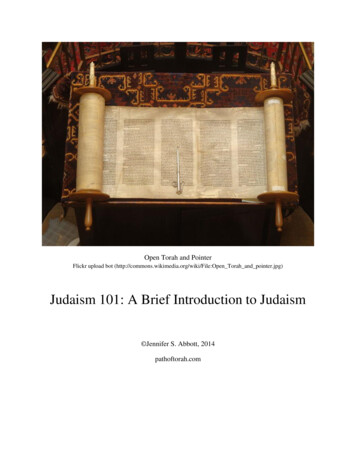

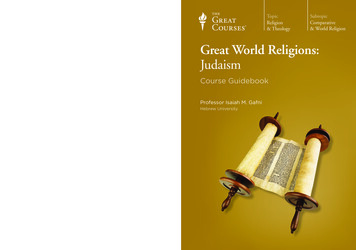

![[Goodman Martin] Judaism in the Roman World](/img/16/goodman-2007.jpg)



